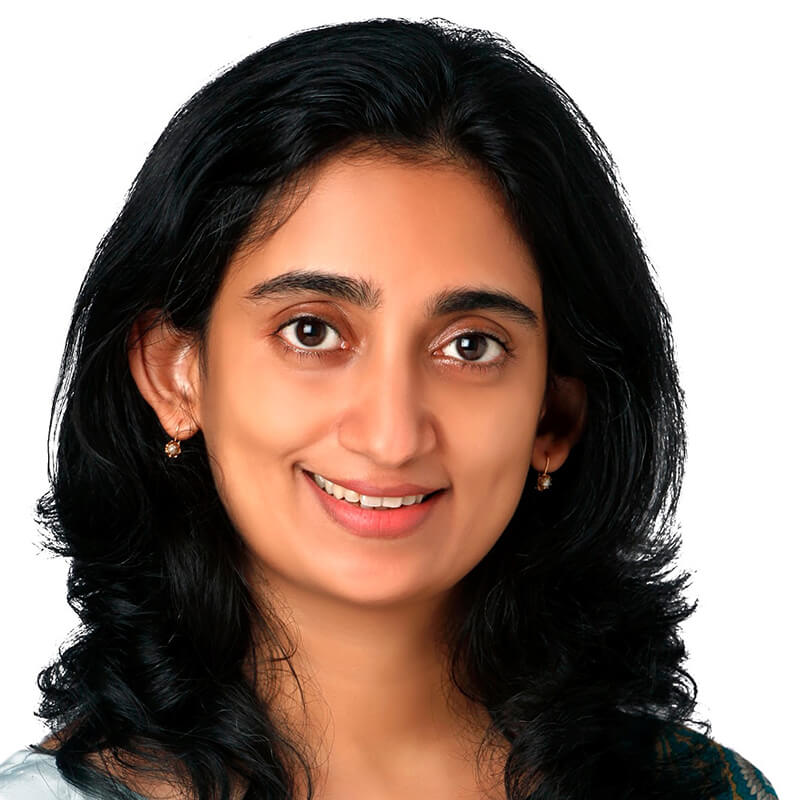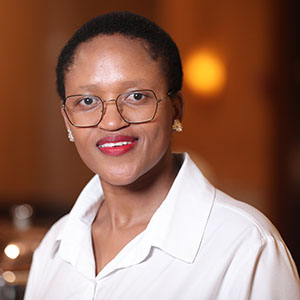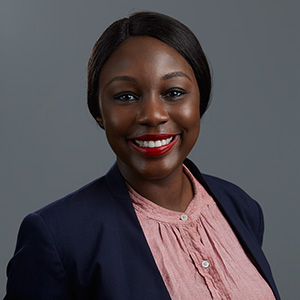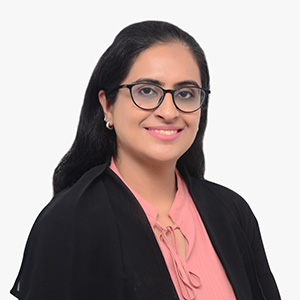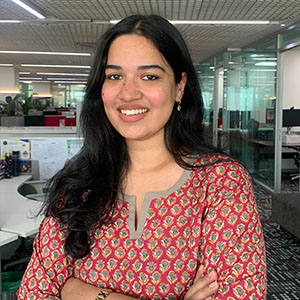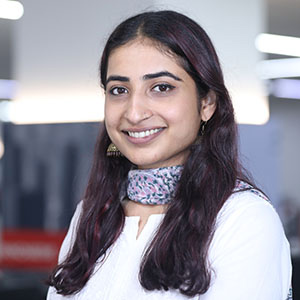In recent years, social-impact practices have increasingly put people at the centre of development initiatives, so that they can become architects of their own change. This approach, called community-driven change (CDC), aims to move communities across a spectrum that ranges from recipients of social-sector beneficence (aka “beneficiaries”), to partners working together with social-sector actors, to owners of their own development priorities. As owners, communities identify, design, and execute solutions to the challenges they face.
We at The Bridgespan Group have extensively researched approaches to CDC since 2020. Repeatedly, we have found that no matter the context – whether it is empowering rural women in Angrekond village in Maharashtra, India, or reducing the risk of HIV in adolescents in South Kamagambo, Kenya – when development programmes are anchored in this process of CDC, it leads to lasting and equitable impact.
Unfortunately, CDC can’t simply be switched on overnight. But it can be advanced, our research has found, as a community bolsters three specific building blocks for CDC. The first two building blocks lie in strengthening the community’s existing power (that is, its ability to participate in decision-making by becoming more aware of its rights, playing an active role in local governance, or increasing collective agency) and assets (both monetary assets and non-monetary ones, such as knowledge, skills, leadership capabilities, and social capital). The third building block flourishes when a community fosters more equity & inclusion (that is, traditionally marginalised voices are heard, and there’s greater social harmony).
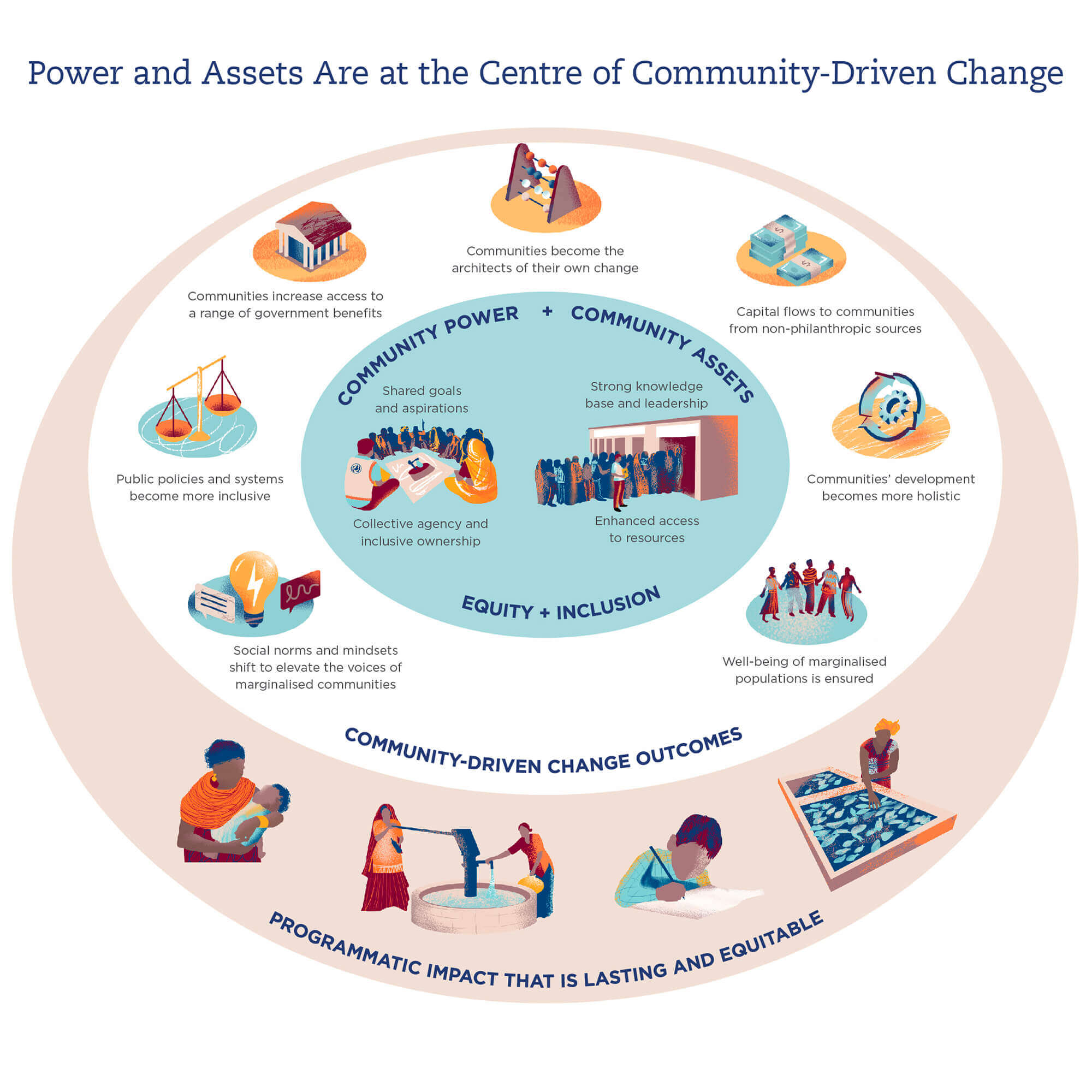
Today, a growing number of social-sector actors are interested in moving away from more traditional “top-down” approaches towards more community-driven ones to ensure their work provides lasting benefits to communities. But when we spoke to funders and nonprofits, specifically in Africa and India, we found a persistent uncertainty around how to assess CDC. That is, how can you effectively track progress and evaluate results when applying a CDC approach to your work? This is the research question we set out to answer in this phase of our multi-year initiative on CDC1, through which we aim to identify and address gaps in the sector to help more funders and nonprofits support CDC approaches. We interviewed over 50 practitioners across India and sub-Saharan Africa, including funders, nonprofits, and intermediaries, who work directly or indirectly with communities to understand if and how they took a CDC approach to their work, and what they learnt that might be helpful for those starting out.2
Additional Resources
If you’re a funder or nonprofit looking to understand what power, assets, and equity & inclusion might look like in the context of your work, and what outputs and outcomes you can track to assess progress on them, refer to our Community-Driven Change Assessment Toolkit.
For a quick guide on what power, assets, and equity & inclusion can look like in communities, refer to our visual primer: What Enables Community-Drive Change?
If you’re looking for additional reading on how CDC leads to lasting change, refer to our report: Demonstrating Impact in Africa and India.
Why Measuring CDC Needs an Unconventional Approach
The more we spoke to funders and nonprofits, the more we realised that there are no easy answers to the question of assessing the progress of CDC. For one, in the early stages of implementation, CDC approaches might look indistinguishable from other development programmes. For instance, they might both aim to improve service delivery or infrastructure, increase economic opportunities, or promote gender equality.
But what sets the CDC approach apart is its focus on the process of building power, assets, and equity & inclusion in the community, which most traditional measurement, evaluation, and learning (MEL) approaches that prioritise programmatic goals fail to include. This means that although organisations might be working closely with communities, they aren’t necessarily tracking how their work is strengthening the building blocks of CDC. Upmanyu Patil, director of programs at Swayam Shikshan Prayog, a nonprofit focused on supporting women entrepreneurs in low-income communities, appraises it succinctly: “CDC needs an approach to impact assessment that focuses on how communities have evolved, not just transactional metrics on how income has increased, or number of farmers helped, etc.”
Even funders and practitioners who are integrating a CDC approach in their work share they could use more practical, sector-agnostic guidance on how to measure this process – which metrics or indicators to track, what success looks like – because it looks so different from one place to another. In fact, that’s another reason why assessing progress on CDC is complex. There’s no one-size-fits-all approach; by its very nature, CDC is contextual to the community it serves.
“CDC needs an approach to impact assessment that focuses on how communities have evolved, not just transactional metrics on how income has increased, or number of farmers helped, etc.”
In our research, we found that practitioners implement widely varying approaches to estimate progress. For some, like Mission Samriddhi, a social-impact platform that works with panchayats (local self-governance bodies) in rural India for holistic and sustainable change, it is measured through data from periodic self-assessments by community members on over 144 success indicators across their five focus areas. For others, like the Warande Advisory Centre (WAC), an organisation that supports collaborative advocacy and research in Africa, it is gleaned from storytelling sessions with the community.
Approaches to assessing progress are not only different but also need constant iteration as the community moves along the CDC spectrum. Assessing progress, therefore, can sometimes feel like a shifting goal post – one that, as many funders and practitioners told us, not everyone has the capacity to explore and execute. Research on how to evaluate adaptive approaches is still nascent; the sector needs more capacity, even amongst MEL specialists, to assess progress when social change unfolds in a non-linear fashion (more on that below), as it does with CDC.
As many nonprofits we spoke to pointed out, there are also inherent power imbalances in the process, both between funders and their grantees, and between social sector actors (funders or nonprofits) and the communities they work with. For instance, funders often have structured reporting mechanisms that don’t account for the iterative, community-first approach for progress assessment that works best with CDC. Or they might have internal challenges (getting a sign-off from their board, for instance) or external obligations (such as country-specific regulatory frameworks) that make it difficult for them to change existing evaluation frameworks. Given the nature of the funder-grantee relationship, this means that sometimes nonprofits end up tailoring their assessments of success more to the needs of funders than communities. Some funders we spoke to also pointed out that the very act of assessing progress can end up reinforcing traditional power hierarchies between the communities and practitioners.
Despite these tensions, we found that more and more funders and nonprofits are not only rising to the challenge but also developing innovative approaches to assessing progress that consider the complex and dynamic nature of CDC. We’ve distilled the common themes that have emerged from our conversations with funders, intermediaries, and implementing nonprofits into four overarching considerations – or guiding principles – for assessing progress on CDC:
- Measure what matters to the community
- Diversify your data
- Make learning central to the process, and adapt accordingly
- Recognise that progress on CDC is a journey, not a destination
These principles can serve as a helpful starting point to understand and address some of the complexities of CDC.
Measure What Matters to the Community
When Saamuhika Shakti, a collaborative of nonprofits supported by the H&M Foundation, began work in Bengaluru, India, it had only one aim: to support informal waste pickers towards building a dignified and successful future. But instead of going in with a sector-specific lens, like improving economic opportunities, it let its programmes be defined and informed by the community’s priorities which, they quickly realised, were much more diverse than they anticipated. Issues ranged from the issuance of job cards for government entitlements to better access to education and sanitation to complex problems like improving the social perception of waste pickers or addressing domestic violence. Today, Saamuhika Shakti’s programmes support many of those issues, and measures of success are informed by the community’s evolving priorities – whether it is the number of successful social-security applications, or the number of women entrepreneurs from the community who now run successful businesses.
While Saamuhika Shakti’s example might seem simple, even obvious, most practitioners we spoke to underscored how difficult it can be in practice to cede power and let success be defined by the community rather than through a sectoral or programmatic lens. But for CDC to work, it is critical to co-create assessment frameworks with, and not for, the community, and ground what you choose to measure in the community’s own aspirations. Only then can communities take ownership of the change they want to see.
“We try and unpack what success can look like for the community before we begin the process of impact evaluation,” says Ronald Kimambo, learning and evaluation officer at Firelight Foundation, a multi-donor fund that supports community-driven organisations in eastern and southern Africa. “We ask them where they see their community over the next 25 years: What do you see as your dream? And how do you think we can track progress towards achieving that bigger picture?”
Admittedly, this process requires significant trust, especially on the part of funders. As Chilande Kuloba-Warria, founder and managing director of WAC puts it, “Metrics [of success] that make funders feel comfortable are not always what make communities feel comfortable.” Practitioners we spoke to highlighted that the process works best when funders provide their grantees – who are closest to the needs of their communities – freedom to choose which metrics to track in consultation with the community. This might mean including culturally responsive metrics that are meaningful for the community, even if they are non-traditional. “For instance, certain Masai communities in East Africa track child health through skin texture and energy during play, which are important to include when you’re assessing early childhood development programmes from a CDC lens,” says Kimambo.
“Metrics [of success] that make funders feel comfortable are not always what make communities feel comfortable.”
Organisations we spoke to also note that the co-creation process can look different depending on the context of the funder and the nonprofit’s work. Several funders emphasise the importance of in-depth field visits as the foundation of this process. “In order to move away from traditional programmatic approaches, [funders] should go to the field to talk to people and hear from them what changes their work has brought about, and what more needs to be done,” says Hillary Omala, investment director at the Dovetail Impact Foundation, which supports community-driven organisations across 35 countries.
Others say that in cases where directly speaking to the community isn’t possible, funders and nonprofits can invest in staff who are from the communities they serve and can speak to the lived experience of the community. “We try to look at how rooted leaders [of the organisations we support] are in the communities they serve,” says Andrew Jones, co-director and impact partner at Imago Dei Fund, which supports community-driven organisations in diverse geographies such as Rwanda, Uganda, Haiti, and Boston. “[Most of] our grantee organisations are small, and their leaders typically come from the communities they serve.”
Diversify Your Data
In 2016, Youth for Unity and Voluntary Action (YUVA) began working with informal domestic workers in the hill settlements of Guwahati in northeastern India. Although domestic workers were indispensable to most households, their lives were marked by low wages that trapped them in intergenerational poverty, and little to no recognition of their rights afforded by state and administrative bodies.
To address this, YUVA helped establish a domestic workers’ collective – Grihakarmi Adhikar Suraksha Samiti – to help strengthen their agency and help them access their rights. But when the collective began to assess progress, it realised that to capture aspects of change it had seen in its members – becoming more self-reliant, having a stronger sense of identity, developing a sense of solidarity with other members – it needed to go beyond numbers and document members’ stories through extensive interviews.
Halfway across the world, WAC does something similar in the communities it works with in Kenya to strengthen locally led development. “Storytelling comes naturally to people, so we tend to use a lot of stories to capture how the community is changing. We create listening spaces, essentially safe spaces for people to come together to communicate, and we keep it very conversational. We ask them: ‘Remember when we came last time? What was happening then? What is happening now? And what has helped us get here?’” says Kuloba-Warria of WAC.
Most practitioners we spoke to underscore what YUVA and WAC practice: the need to let go of traditional hierarchies of data – where only quantitative metrics are considered accurate and reliable – and lean into more qualitative data, gathered through interactions with the community, to track progress on complex change like an increase in a community’s sense of ownership or a shift in social norms.
Storytelling, in particular, comes up as an important tool that can add significant depth and colour to the community’s experience of driving its own change. The Trevor Noah Foundation, for instance, which works with youth in South Africa to improve access to quality education, recognises that outcomes like “co-ownership,” which are critical to the CDC process, can be best understood through qualitative narratives. “We use storytelling as a tool,” says Shalane Yuen, founding managing director of the foundation. “Outcomes like co-ownership can be difficult to measure quantitatively, unless you are counting [say] number of engagements, which doesn’t always capture the full picture.”
Of course, quantitative data has its place – and we found that depending on where the work takes place and the context surrounding it, some nonprofits prefer to use quantitative markers, tweaking them to show the strengthening of the community’s power and assets. But overwhelmingly, we heard from practitioners that assessing progress on CDC requires a balance of both quantitative and qualitative data to truly capture the holistic nature of the process. As Anagha Mahajani, chief impact officer at Ambuja Foundation, a nonprofit that works with rural communities in India, puts it: “CDC is all about people. If you don’t have qualitative indicators in your measurement, you’re missing out on something core. You also need data to back your anecdotes – but one shouldn’t supersede the other. It is important to strike a balance with both.”
“CDC is all about people. If you don’t have qualitative indicators in your measurement, you’re missing out on something core. You also need data to back your anecdotes - but one shouldn’t supersede the other. It is important to strike a balance with both.”
It is not enough to diversify the type of data you collect; most practitioners we spoke to emphasise the need to diversify data collection methods as well, to meet communities where they are, and consider how they feel most comfortable sharing information. “In some communities we work with in rural East Africa, illiteracy rates are high. So, it is important to use appropriate participatory approaches to ensure that data collection is inclusive,” says Kimambo of Firelight Foundation. “One approach could be to use rating tools like ‘smiley-face pockets’: community members can respond to a specific question – such as progress on an activity in the action plan – by placing a small stone or a written response in a designated smiley pocket [that represents their level of satisfaction].” Practitioners also highlighted the need to train community facilitators in these participatory methods as well as fine-tune their interviewing skills, to enhance the quality and depth of the information captured.
Make Learning Central to the Process and Adapt Accordingly
For Ambuja Foundation, becoming comfortable with change has been instrumental in tackling the significant problem it wants to address: supporting rural families in India to transition out of poverty. The foundation works across a host of interventions, from making communities more drought-resilient and improving farmers’ profitability, to upskilling rural youth with training and employment opportunities. Given the diversity of its work, and the complexity of the problem it wants to solve, it is constantly asking what is working, and adapting as needed. “We have a dynamic system [of evaluating progress] and list of indicators [we track]; our programmes and processes keep evolving,” says Mahajani. “Every year, we seek feedback from all our different stakeholders, including the communities [we work with], and review and update our programme planning as needed. This has led to significant improvement in both our programmes and our assessment processes over the years.”
Most practitioners we spoke to agreed that change is at the heart of assessing progress on CDC. As communities move across the CDC spectrum, their motivations and aspirations change to match the evolving state of their power, assets, and equity & inclusion – and assessment requirements, too, need to evolve to keep pace. Being adaptable and responsive to these changing conditions makes assessing the progress of CDC most effective. But to do that, the process of tracking progress must be rooted in a culture of learning, rather than used as a tool to audit or as a yardstick for success. The questions to ask, as Ambuja Foundation illustrates, is not merely what has been achieved, but what can we learn from the information gathered during the assessment process? And what adjustments do we need to make to better support the community to pursue its developmental priorities?
Building this culture of iterative and adaptable assessment is good for all programmes, but it is especially important for CDC since it helps “close the loop” with the community, informing them of what has been learnt through the assessment process and making meaning of it together. Most importantly, it avoids data extraction. As Shaheen Kassim-Lakha, senior director of strategic partnerships at the Conrad N. Hilton Foundation, explains, “We’re getting better at asking communities what they want — but too often, those insights are forgotten. When they are considered, it is usually only during the strategy phase, and rarely acknowledged as a meaningful contribution. If we’re serious about truly partnering with communities, we need to return to them throughout the entire [assessment] process.”
Keeping the community abreast of insights from the data collected, celebrating progress and discussing challenges, not only builds transparency and accountability but also provides an opportunity for the community to provide feedback on the entire process. The feedback is critical for funders and nonprofits to become more responsive to the community as they continue their CDC journey, as well as to surface and address any biases. “All data is shaped by the methods, contexts, and limitations under which it is collected. Proxy indicators, especially, might not always fully reflect [these] vulnerabilities,” says Sana Satpathy, senior policy manager at global research centre Abdul Latif Jameel Poverty Action Lab, South Asia. “[That’s why] communities should be involved [in the assessment process] to figure out what is really working for them.”
Practitioners we spoke to say that they build in time to reflect during their evaluation processes, both with internal stakeholders and with communities, to assess what is working, what is not, and where assumptions need to be revisited. As Guillermo Nimmagadda, manager at MicroSave Consulting, puts it, “Rarely does an organisation get [assessing progress on CDC] right in the beginning. Whether it is an NGO or a government, the measurement framework is difficult to design. These processes are highly iterative, and there needs to be a strong focus on reflection: What are the metrics we started with? Which were most useful? Do we need to add more, or do we need to drop some of them? Otherwise, this becomes less and less relevant, both to the organisation and the community.”
“These processes are highly iterative, and there needs to be a strong focus on reflection: What are the metrics we started with? Which were most useful? Do we need to add more, or do we need to drop some of them? Otherwise, this becomes less and less relevant, both to the organisation and the community.”
Several practitioners also point out how measuring to learn also goes hand-in-hand with flexibility, particularly in terms of reporting structures. The idea is to have data that is good enough to influence decision-making, instead of getting caught up in complex reporting structures that overburden both the community and the nonprofit.
“For reporting, we ask our partners to submit reports generated from the field versus being prescriptive and asking them to create a new report just for us. This can include impact stories and videos, whatever they think will be useful in tracking progress and learning from it,” says Hillary Omala, from the Dovetail Impact Foundation.
Agroecology Fund, which supports nonprofits that work with smallholder and marginal farmers to transform India’s food systems, echoes a similar sentiment. Minhaj Ameen, director of strategic operations, finance, and administration, puts it this way: “We don’t believe in outputs and outcomes [when it comes to assessing progress]. The idea is to encourage partners to share learnings, both with us and with larger platforms and communities. We know conditions are changing constantly on the ground, so we don’t want to be prescriptive with our requirements.”
Recognise That Progress on CDC Is a Journey, Not a Destination
When Legado started its work in Mozambique, it focused primarily on working with Indigenous and local communities to understand their conservation priorities. Over time, it realised that the community does not perceive its challenges in silos, and conservation cannot be addressed without addressing the overall well-being of Indigenous and local people. In response, Legado developed its Thriving Futures model, which builds on local knowledge and utilises community assets to activate individual and collective legacy so that Indigenous people can take the lead on designing solutions relevant to the challenges they face.
Similarly, the Swades Foundation in India began as a direct-service nonprofit that provided toilets and clean water connections to communities in the Raigad district of rural Maharashtra. Over time, the foundation realised that for impact to be sustained, communities must take ownership of the change they want to see. As a result, it changed its approach and set up village development committees (VDCs) that support communities to gain skills to generate more income, become more aware of their rights, and build their agency.
Like Legado and Swades Foundation, almost all practitioners we spoke to recognised that progress on CDC is non-linear; in fact, where you end up might be very different from where you thought you were going. You might, for instance, begin with the aim of improving girls’ education but quickly realise that unless other interrelated factors – like social norms around gender, a family’s financial ability to send its daughters to school, even well-lit roads and easily accessible toilets that allow girls to continue their studies – are addressed, the results you hoped to see might be out of reach. This shifting goal post is a part of the nature of CDC, and it asks funders and nonprofits to be comfortable with uncertainty rather than to expect predictable results along a pre-defined timeline, as with more programmatic approaches. When assessing progress on CDC, it is less about ticking off boxes of what was “achieved” and more about assessing how change is happening within the community, and whether the community is being engaged throughout the process. That is why the journey itself is as important, if not more, than the destination.
“The process – how communities reach decisions, co-create solutions, and develop governance structures – needs to be explicitly valued. Without this, there is a risk that funders only support ‘ready-made’ community-led solutions rather than the longer-term work required to develop inclusive, community-owned strategies.”
As Majka Burhardt, CEO and founder of Legado, puts it, “Process matters. Funders often fund end-products of community-led design, but the process of community engagement itself must be supported. The process – how communities reach decisions, co-create solutions, and develop governance structures – needs to be explicitly valued. Without this, there is a risk that funders only support ‘ready-made’ community-led solutions rather than the longer-term work required to develop inclusive, community-owned strategies.”
That’s not to say that tracking progress on pre-determined “outputs” and “outcomes” aren’t important. But since outcomes typically take time in a CDC approach, many organisations are pivoting to what Krishanu Chakraborty, former associate director at research organisation IDInsight, describes as “process evaluation.” Chakraborty explains, “The idea is that, early on in your work, you are focused not on your impact, but more on the quality of your activities, and whether your processes are working well. This will, over time, lead to improved outcomes.”
External factors also come into play wherever large-scale social change, that CDC aspires to, is involved, which is another reason why progress on CDC is non-linear. For example, regulatory or policy changes, changes in government, access to markets, private players, or even natural calamities – factors that funders, nonprofits, or even communities, have little control over – can play a critical role in determining success on things like social norms or income levels in communities. That is why attribution is a difficult tightrope that practitioners must walk – and it is not always possible to say “if we do this, it will lead to that.”
And because attribution is not always possible, the process itself needs to be valued. As Anusha Chandrasekharan, lead of programmes at Praxis, an organisation that works on inclusive and participatory approaches to development, sums up, “While measuring goals, we shouldn’t forget about the journey. Even if [the goals] are not achieved, the journey – moving a community one step closer to become architects of their own change – is, in itself, immense.”
***
While these guiding principles might seem simple, we recognise that they are not easy to implement. They require moving away from conventional approaches to meet the unique needs of community-driven change. But if there’s one thing we took away from our conversations with CDC practitioners, it is this: it is better to measure progress on CDC imperfectly than to not track the CDC process at all. Because, ultimately, the benefits of assessing progress on CDC far outweigh the strain of any initial hiccups; in fact, the process itself makes both practitioners and the community more open to learning, iterating, innovating, and even embracing failure if needed. Ultimately, this helps build stronger programmes and creates equitable change for years to come.
Reflection Questions
To help you get started with implementing these guiding principles, here is a list of reflection questions:- Does your idea of success align with that of the community you are working with? Does it incorporate the lived experience of the community?
- What kind of data do you plan on capturing to assess progress? What will it help you, and the community, learn?
- Does your data include both qualitative and quantitative metrics? Are your data collection methods inclusive and accessible?
- How do you plan on going beyond only consulting the community to involving them across the various steps of the assessment process?
- How will you incorporate feedback from the community throughout your assessment process? How will you iterate based on this feedback? How will you close the loop with the community?
- Are your reporting structures flexible enough to accommodate for the non-linear nature of CDC?
- How do you elevate the value of CDC as a process, not just a means to an end?
- Given the external factors at play that influence outcomes, how do you look at the standards of evidence that can attribute results to the CDC process?
Acknowledgements
This research would not have been possible without the contributions of the 50-plus organisations that we spoke to. We are grateful for their time and their insights. (A full list of organisations interviewed can be found below.)
We would also like to thank our colleagues Debby Bielak, Lija Farnham, Robert Searle, and Rohit Menezes for their strategic guidance throughout the project; Larry Yu and Carole Matthews for their support in shaping this research; Suzanne Hughe, Michelle Cherian, and Shashwata Nova for their support in editing and designing this report; and Mapitso Mohube, Carol Dlima, and Pinky Thakkar for operational support on this project. The Community-Driven Change multi-year initiative would not have been possible without the support of our anchor partners: the Children's Investment Fund Foundation, the Conrad N. Hilton Foundation, Target Foundation, the Global Alliance for Communities, H&M Foundation, Humanity United, the Rohini Nilekani Philanthropies, Swades Foundation, and Veddis Foundation.


